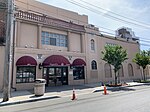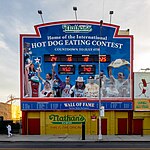Childs Restaurant (Boardwalk)

The Childs Restaurant Building on the Boardwalk is a New York City designated landmark on the Riegelmann Boardwalk at West 21st Street in Coney Island, Brooklyn, New York City. It was completed in 1923 for Childs Restaurants, an early restaurant chain and one of the largest in the United States at that time. It was designed in a "resort style with Spanish Revival influence" with colorful exterior terra cotta ornamentation that references its seaside location, with depictions of Poseidon, sailing ships, and sea creatures. It was a very large restaurant, with three stories and a roof garden.Childs vacated the property in 1952. The building was used as a candy factory for over 50 years but was vacant and in a state of bad repair until it was converted into the Ford Amphitheater at Coney Island in 2013–2015. A considerably smaller prior Childs location in Coney Island, built in 1917 at Surf Avenue and West 12th Street and also a designated New York City landmark, survived as a Childs until 1943. Today it is owned by Coney Island USA, an arts organization.
Excerpt from the Wikipedia article Childs Restaurant (Boardwalk) (License: CC BY-SA 3.0, Authors, Images).Childs Restaurant (Boardwalk)
West 21st Street, New York Brooklyn
Geographical coordinates (GPS) Address Nearby Places Show on map
Geographical coordinates (GPS)
| Latitude | Longitude |
|---|---|
| N 40.5725 ° | E -73.9876 ° |
Address
West 21st Street 2101
11224 New York, Brooklyn
New York, United States
Open on Google Maps










